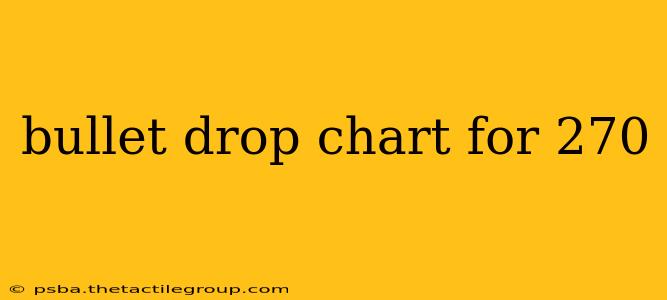The .270 Winchester remains a popular choice for hunting and long-range shooting, renowned for its accuracy and flat trajectory. However, understanding bullet drop at various ranges is crucial for making accurate shots. This article provides a comprehensive guide to bullet drop for the .270, explaining the factors influencing it and offering practical advice for compensating for bullet drop in the field. We will focus on providing a general understanding, as specific bullet drop will vary considerably based on several factors.
Factors Affecting Bullet Drop in .270 Winchester
Several variables influence how far a bullet drops at a given range. Ignoring these crucial elements can lead to missed shots.
-
Bullet Weight: Heavier bullets generally experience less drop due to higher momentum. Lighter bullets are more susceptible to wind drift and gravity's pull.
-
Muzzle Velocity: A higher muzzle velocity translates to a flatter trajectory and reduced bullet drop. Different ammunition loads will offer varying muzzle velocities.
-
Ballistic Coefficient (BC): BC measures a bullet's aerodynamic efficiency. Higher BC bullets cut through the air more effectively, experiencing less drop and wind drift. This is a crucial factor to consider when choosing ammunition.
-
Altitude and Air Density: Higher altitudes and lower air density result in less air resistance, reducing bullet drop. Conversely, dense air at lower altitudes causes increased drop.
-
Temperature: Temperature affects air density, impacting bullet trajectory. Colder air is denser, leading to slightly more bullet drop.
-
Wind: Wind is a significant factor, particularly at longer ranges. Crosswinds will push the bullet off course, and headwinds will increase drop while tailwinds will decrease it.
Creating Your Own Bullet Drop Chart
While we can't provide a specific bullet drop chart applicable to all .270 Winchester ammunition, understanding how to create one is crucial for accurate shooting. You'll need the following:
-
Ballistic Calculator: Numerous online ballistic calculators and software programs are readily available. Many are free, while others offer advanced features for a fee. Inputting the specific bullet weight, BC, muzzle velocity, and environmental conditions will allow you to generate a detailed chart.
-
Accurate Data: Inputting accurate data is paramount. Use the manufacturer's specifications for bullet weight and BC, and measure environmental conditions as precisely as possible.
-
Testing: For the most accurate results, conduct your own range testing. This allows you to account for variations in your specific rifle and ammunition. Record your zeroing distance and the point of impact at different ranges.
Interpreting a Bullet Drop Chart
A typical bullet drop chart will show the vertical distance (in inches or centimeters) the bullet drops below the line of sight at various ranges. For instance, it might show a drop of 3 inches at 200 yards, 12 inches at 300 yards, and so on. This data is crucial for adjusting your aim to compensate for bullet drop and ensure accurate shots.
Practical Application: Zeroing Your Rifle
Zeroing your rifle is the first step towards accurate shooting. Most commonly, shooters zero their rifles at 100 yards. This means adjusting the sights so the bullet hits the point of aim at 100 yards. However, understanding bullet drop at longer ranges allows you to anticipate and compensate for it.
Conclusion: Knowing Your Ammunition
Understanding bullet drop is essential for successful long-range shooting with a .270 Winchester. While a general bullet drop chart cannot be provided due to the multitude of ammunition variations and environmental conditions, the information presented here empowers you to create a personalized chart tailored to your specific setup and shooting conditions. Remember to always prioritize safety and practice responsible firearm handling.

